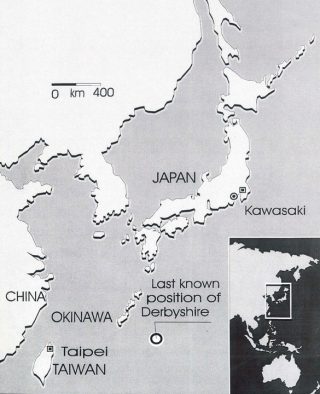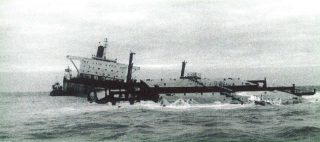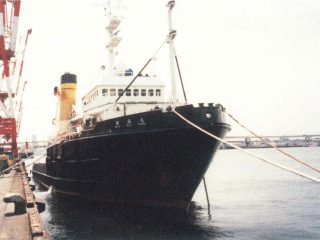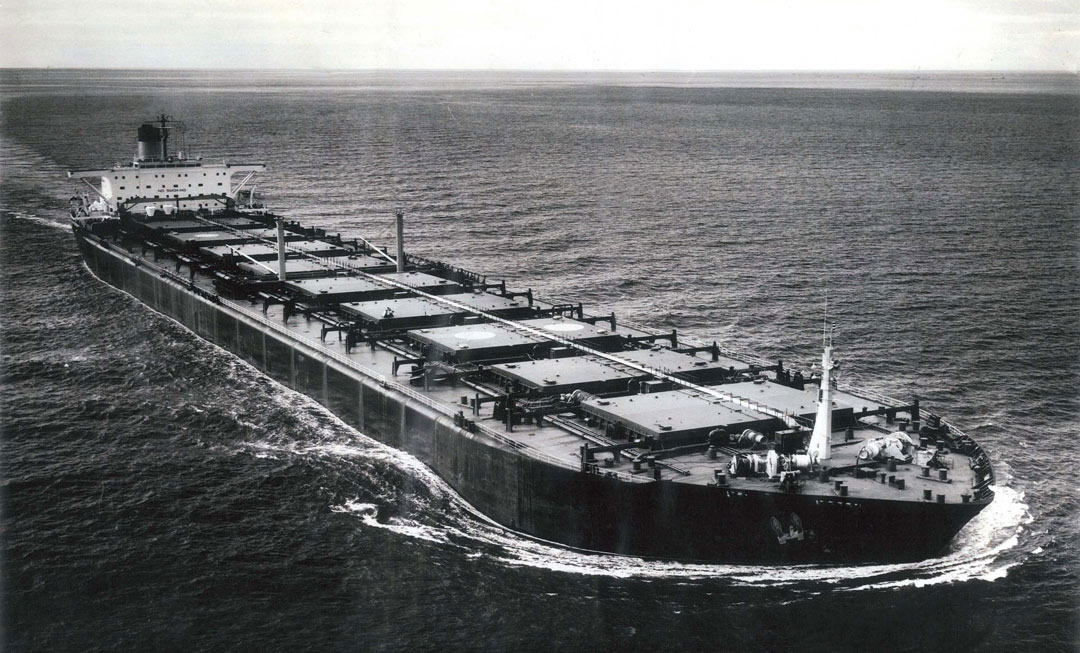The sinking of MV Derbyshire
Source: https://www.liverpoolmuseums.org.uk/merseyside-maritime-museum
An extraordinary loss
MV Derbyshire is the biggest British registered merchant ship ever to have been lost at sea.
Built in 1976, she was an oil/bulk/ore (OBO) carrier. A Liverpool registered ship, she was owned by the local firm Bibby Line. On her final voyage more than a third of the crew were from Liverpool.
She was lost in September 1980 in the South China Seas during typhoon Orchid, en route from Canada to Japan. All 44 people onboard died, including 42 crew members and 2 of their wives.
In the 1980s about 17 bulk carriers were lost each year. The loss of Derbyshire was extraordinary because:
- she was only 4 years old
- she was manned by an experienced master and crew
- she was built by a British shipyard
- she was classed A1 by Lloyds Register, the top classification for merchant ships
Incredibly it was 20 years before the reasons for the sinking were discovered. This is the story of how the families of the lost crew fought to discover the truth.
The final voyage of MV Derbyshire
The Derbyshire’s final voyage started on 11 July 1980, when she left Canada for Japan carrying 157,446 tonnes of iron ore
A few days before arrival in Japan she was overwhelmed by typhoon Orchid. Her last known message, on 9 September 1980, reported a severe tropical storm.
Unusually, no ‘MAYDAY’ distress message was heard.
Declared lost
On 15 September 1980 the search commenced but was called off by 21 September as nothing was found and the ship was declared lost.
The families of those who died were then told that the Derbyshire had been lost. They were devastated and could not understand how such an enormous ship could have disappeared without trace.

Location map of where MV Derbyshire was lost. Copyright ITF, reproduced with kind permission
On 20 September 1980 the Bibby Line vessel Cambridgeshire held a ‘floral tribute’ memorial service at sea, in the vicinity of the Derbyshire’s last reported position. Captain Kenneth Gowsell, the master of the Cambridgeshire reported that:
“…the ship’s company mustered on the poop, at daybreak on 20 September, where a table had been erected with a Red Ensign covering it, on which eight floral tributes were placed. The ship’s ensign was at half mast on the jack staff. With the engine stopped and the ship silent a short service took place”
Searching for the truth
A formal investigation?
The families of the crew who died on MV Derbyshire wanted a formal investigation.
The UK Government refused because, without evidence, a formal investigation was not warranted. They did however ask two independent bodies to conduct research into the loss.
The Derbyshire Family Association (DFA) was formed in order to lobby for a formal investigation. It took the families twenty years before they learned how their loved ones had perished
A sister ship in trouble
In March 1982 one of Derbyshire’s five sister ships, the Tyne Bridge, encountered severe weather in the North Sea and her deck plating started to crack just forward of the bridge in an area known as frame 65
The four other remaining sister ships were contacted. Each one in turn found similar damage in the same location. It was found that the Derbyshire had also had a similar but lesser problem in the same location
Investigating frame 65
Peter Ridyard, the father of the 4th Engineer on the Derbyshire, was a very experienced ship surveyor. He was convinced that a ship like the Derbyshire should not have sunk so he collected information about the damage to her sister ships.
He sent this data to the Department of Transport (DOT) in September 1982 and again in June 1983 but received no response.
In July 1985 the DOT issued a draft report that suggested that Derbyshire might have been lost due to damage in front of the bridge in the region of frame 65.
The Derbyshire Family Association was angered when, in March 1986, the DOT published the report in a much modified form, saying that the loss of the ship could have been due to various other reasons.
Another sister ship in trouble

MV Kowloon Bridge aground on Stag Rock off the south coast of Ireland
On 18 November 1986 another one of Derbyshire’s sister ships, MV Kowloon Bridge (originally called the English Bridge), developed severe deck cracking at frame 65 in the North Atlantic.
On 20 November she anchored in Bantry Bay, Eire. Two days later she dragged her anchor and put to sea again. She then lost her rudder and went aground on rocks in the South Irish Sea. Shortly after that she broke her back near frame 65.
Following the loss of the Kowloon Bridge the UK Government agreed to hold a formal investigation into the loss of the Derbyshire, which took place between October 1987 and March 1988.
The conclusion was announced on 18 January 1989, almost nine years after the loss of Derbyshire. The families learnt of the findings from press reports.
The formal investigation concluded that:
“For the reasons stated in this Report the Court finds that the Derbyshire was probably overwhelmed by the forces of nature in typhoon Orchid, possibly after getting beam on to wind and sea, off Okinawa in darkness on the night of 9/10 September 1980 with the loss of 44 lives. The evidence available does not support any firmer conclusion”
The families were outraged that the evidence from the wreck of the Kowloon Bridge had seemingly been ignored. Convinced that frame 65 had something to do with the loss of the ship, they demanded an underwater survey. However they were told that the exact location of the wreck was not known and that there was no adequate technology to find the wreck
Support for the families
In June 1990, Tyne Tees Television took up the fight through the ‘Northern Eye’ programme, with a half hour long documentary about the Derbyshire.
Throughout 1990, Eddie Loyden, a Liverpool MP, was very active in the House of Commons and continued to press for the inquiry to be re-opened.
A team from Brunel University then produced results of research they had conducted, which showed that the stresses near Frame 65 were greater than previously thought.
On 14 December 1990 the Derbyshire Family Association (DFA) presented a petition to the House of Commons containing 47,000 signatures. The petition, which asked for the inquiry to be reopened, was later taken to No 10 Downing Street but the Government still could not be persuaded to look for the wreck of Derbyshire.
A book ‘A Ship too Far’ was published in 1992. It told the Derbyshire story up to that date and put more pressure on the government to reopen the inquiry
The ITF search for the Derbyshire

Shin Kai Maru, the offshore support ship used to search for the wreck of MV Derbyshire in 1994
On 29 May 1994 the US firm Oceaneering Technology started looking for the Derbyshire, using the search vessel Shin Kai Maru. Their search was run and paid for by the International Transport Federation (ITF).
Had it not been for the persistence of the Derbyshire Families Association, the seafarers unions and others, it is possible that the ITF would never have agreed to fund the search. It follows that, had the Derbyshire not been found, the reasons why this massive ship had been lost might never have been discovered.
Derbyshire found!
The ITF search was one of the most ambitious projects ever undertaken by a trade union organisation. Happily it turned our to be a resounding success and the Derbyshire was found in the search area after only 23 hours.
The ITF team together with Oceaneering Technologies, on board the off-shore support ship Shin Kai Maru, started the search in May 1994 in an area based on positions where oil had been seen upwelling in 1980. The sea is about 4200 metres (2 ½ miles) deep at this point.
The Ocean Explorer 6000, a towed side scan sonar vehicle, was deployed from the ship ‘flying’ at an altitude of 460 metres above the seabed and within hours targets were noted which could have been the wreck of a ship. To identify the wreckage, the remotely controlled deep ocean vehicle Magellan 725 ROV was then used.
Before leaving the site the ROV lowered a memorial plaque onto the wreckage and recovered a small amount of the iron ore cargo that could be seen glistening on the sea bed and on parts of the wreck.
News at last for the families
The families were told and after fourteen years they started to grieve again.
The UK Government now took action and, after a further study by Lord Donaldson, a second expedition was organised at a cost of £2 million, paid for by the UK and EU.
The second expedition to the wreckage
The second expedition was conducted in two phases during 1997 and 1998, using two underwater vehicles, one to obtain a broad view of the wreckage and the other for a more detailed inspection.
The technical achievements of the survey were exceptional. 135,774 individual electronic photographic stills were taken, then joined up to make larger pictures. Some 2500 separate items of wreckage were identified and some 200 hours of video footage were recorded.
With all this evidence there was a lot of work to do before the reasons why the Derbyshire sank would be known. It took almost 11 months to publish the results
It was established that frame 65 had not caused the loss of the ship. Instead the conclusion was that the ship had sunk because the lid to a store hatch on the fore deck had been left unsecured. Water had then flooded into the fore part of the ship causing the bow to sink down deep into the momentous seas.
The hatch on number one cargo hold had then failed under the weight of the seas and the hold flooded, making the bow sink even deeper. As the bow gradually sank deeper each hatch cover in turn collapsed under the weight of the seas and each hold filled with seawater.
This conclusion was deeply upsetting to the families because the claim that the store hatch had not been properly secured implied serious negligence on the part of the crew
Public inquiry reopened
The Government reopened the formal investigation, which started on 5 April 2000 and lasted 54 days. Evidence was taken from a number of experts.
The inquiry decided that, contrary to the findings of the second expedition, the flooding of the fore part of the ship was not caused by the store hatch being unsecured. Instead it discovered that some of the air pipes on the foredeck were damaged by continuous mountainous seas.
The sea started crashing onto number one hatch cover as the bow dropped lower in the water. As the hatch cover was not designed to withstand such enormous pressures it eventually gave way and water flooded number one hold, so the bow went down even more. The same happened to the other hatches one after the other, until each hold filled with water and the ship finally sank.
The inquiry concluded that it was most unlikely that the ship had been lost due to any other cause – including faults at Frame 65. A number of significant recommendations to improve ship safety were made as a result of their findings, which are gradually being implemented.
To the relief of the families, the crew were cleared of blame for the loss of the Derbyshire. The DFA accepted the conclusions of the court.
There is little doubt that the twenty year fight of the DFA to learn the truth about the Derbyshire has had a marked effect on the safety of bulk carriers. Whereas in the 1970s about 17 bulk carriers were being lost each year, the losses are now much lower.
The Derbyshire Family Association continues to fight for increased safety at sea and is consulted by the Marine and Coastguard Agency (MCA) and the International Maritime Organisation (IMO)
